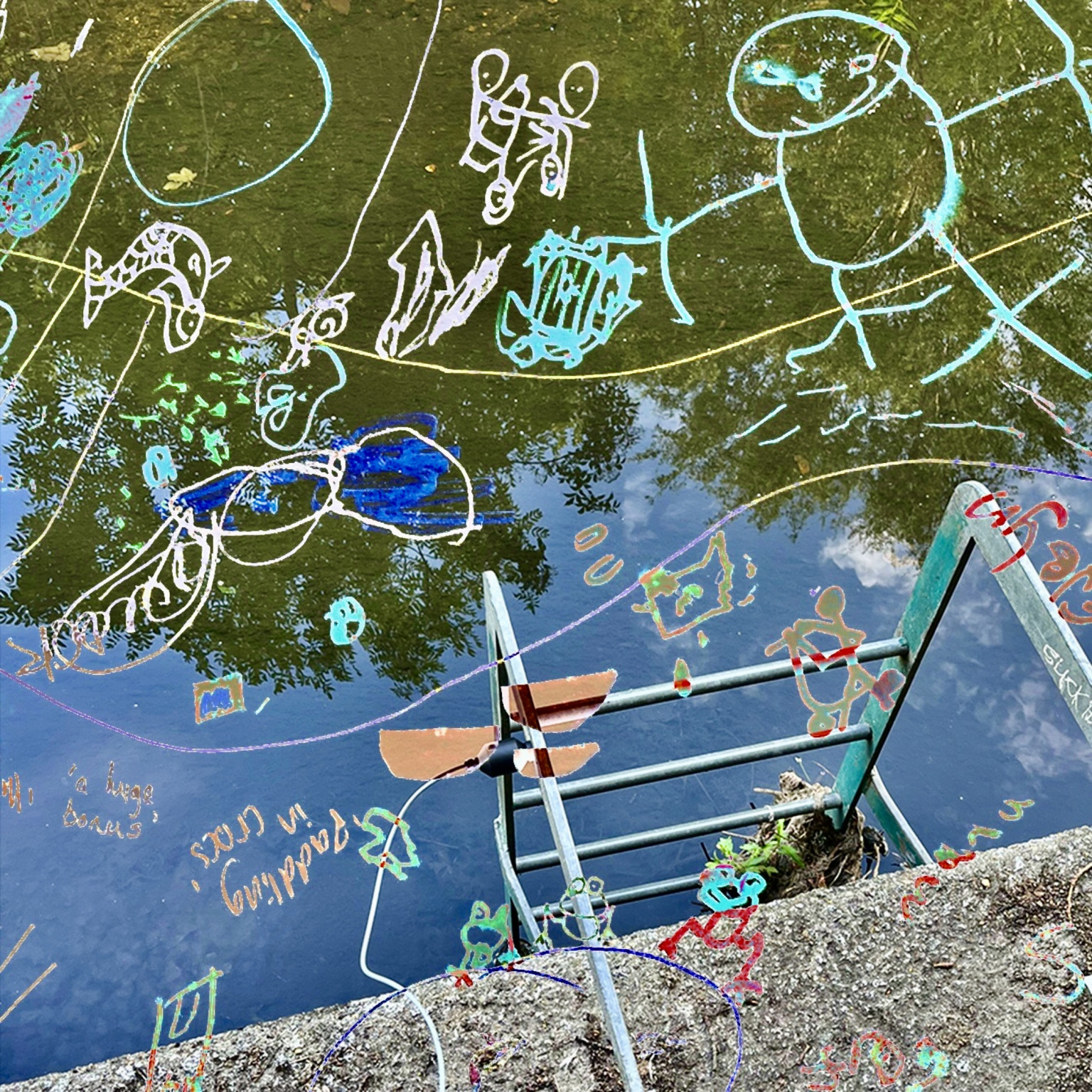Listening for mermaids

Abstract
Along and in the rivers of Lewisham in south-east London, we hear stories of mermaids, treasure chests, crocodiles and, dwelling in a dark corner of Deptford Creek, the Necker, some say a merperson or a serpent.
In this audio paper, we explore these ethereal and slippery stories through listening to the landscape, examining the role of sound in the ongoing process of producing places (Massey, 1994). We consider how sound conjures the imagined mermaids and other watery creatures and foregrounds the pluralities and possibilities of places (Voegelin, 2021). In a reciprocal feedback loop, sounds give rise to certain imaginings and, once imagined, these sounds confirm the existence of what we think or know we heard.
The imaginings are intimately tied in with everyday forms of place-making along Lewisham’s rivers – picnicking, graffiti-writing, playing and birdwatching. They are also a response to the liminality of such spaces; concerns about safety after dark or uncertainty about what is in or under the water equally giving rise to mythical creatures.
In turn, the imaginings layer onto the multiplicity of trajectories and practices intersecting to create places (Massey, 2012). Entwined in this are the landscape’s sounds - field recordings, interviews, and music that the rivers recalled to us. Sounds which are not echoes of places but active in their production.
Through the sonic personae of mermaids, we suggest listening confluently to grasp sound’s role in texturing the rivers’ ambiguous and otherworldly qualities. Like the confluence of two streams of a river, listening confluently opens a crack in any notion of place, allowing other stories to issue forth.
Along and in Lewisham’s rivers we invite (in fact, impel) you to listen confluently; to listen for mermaids and the places in which they dwell.
Listening on your mobile device? Here's a direct link to Soundcloud
Keywords
Bibliography
Bacchilega C. and Brown M.A. (2019). The Penguin Book of Mermaids. New York: Penguin Books.
Drever, J.L. (2019). »Primacy of the ear – But whose ear?: The case for auraldiversity in sonic arts practice and discourse.« Organised Sound, 24(1), 85-95. doi:10.1017/S1355771819000086
Deleuze, G. (2014). Difference and Repetition. 2nd edition. London: Bloomsbury Publishing.
Ellison, B. and Bailey, T.B.W. (2022). Sonic Phantoms: Composition with Auditory Phantasmatic Presence in F. López (ed.) New York: Bloomsbury Academic.
Eshun, K. (1998). More Brilliant than the Sun: Adventures in Sonic Fiction. London: Quartet Books.
Kaika, M. (2005). City of Flows: Modernity, Nature, and the City. New York, NY: Routledge.
Lao, M. (1998). Sirens: Symbols of Seduction. Rochester: Park Street Press
Massey, D. (1994). Space, Place and Gender. Cambridge and Malden: Polity Press.
Massey, D. (2012). For Space. 1. publ., repr. Los Angeles, Calif.: Sage.
Schulze, H. (2018). The Sonic Persona: An Anthropology of Sound. New York: Bloomsbury Academic.
Schulze, H. (2020). Sonic Fiction: The Study of Sound. New York: Bloomsbury Academic.
Stifjell, C. (2022). »Submersive Mermaid Tales: Speculative Storytelling for Oceanic Futures«. Feminist Review, 130(1), 97-101. https://doi.org/10.1177/01417789211064886
Voegelin, S. (2021). Sonic Possible Worlds: Hearing the Continuum of Sound. Revised edition. New York: Bloomsbury Academic.
Discography
4hero (2009). »The Paranormal in 4 Forms«, Parallel Universe [CD]. London: Reinforced Records.
Ellison, B. (2018). »Sonic Phantoms#9«, Sonic Phantoms [Bandcamp].
Papakonstantinou, T. (2000). »Pechlivanis«, Vrachnos Profitis [CD]. Athens: Lyra Records.
Podcastography
Jackson, E. and Rondel, L. (no date a). Confluence. Available at: https://soundcloud.com/confluencepodcast/episode-1?si=cbda8d5521974d1bbf4affa16457ede9&utm_source=clipboard&utm_medium=text&utm_campaign=social_sharing
Jackson, E. and Rondel, L. (no date b). Confluence. Available at: https://soundcloud.com/confluencepodcast/episode-2?si=f45934864c7c4713b04eadb765c3992e&utm_source=clipboard&utm_medium=text&utm_campaign=social_sharing
Further reading
Barton, J., Kronic, M.B. and Goodman, S. (eds) (2024). Sonic Faction: Audio Essay as Medium and Method. Falmouth: Urbanomic Sequence PR.
Bonnet, F.J. and Szendy, P. (2016). The Order of Sounds: A Sonorous Archipelago. Translated by R. Mackay. Falmouth: Urbanomic (Mono, 2).
Chaney, A. J. B., Stewart, B. M., and Engelhardt, B. E. (2018). »How algorithmic confounding in recommendation systems increases homogeneity and decreases utility«. In Proceedings of the 12th ACM Conference on Recommender Systems, Vancouver British Columbia Canada: ACM, 224-232.
Cohen, J.J. (1996). »Monster Culture (Seven Theses)«. In Cohen, J.J. (ed.). Monster Theory: Reading Culture. Minneapolis: University of Minnesota Press. 3-25.
Deutsch, D. (no date). »Phantom words«. Available at: http://deutsch.ucsd.edu/psychology/pages.php?i=211
Fisher, M. (2016). The Weird and the Eerie. Third edition. London: Repeater Books
Gumbs, A.P. (2021). Undrowned: Black Feminist Lessons from Marine Mammals. Edinburgh: AK Press.
Montin, S. and Tsitas, E. (eds.) (2019). Monstrous Geographies: Places and Spaces of the Monstrous. Leiden: Brill.
Neimanis, A. (2019). Bodies of Water: Posthuman Feminist Phenomenology. London: Bloomsbury Academic.
Pedersen, T. (2018). »Thinking with mermaids here and now«. Shima: The International Journal of Research into Island Cultures, 12(2), 250-255. Available at: https://www.shimajournal.org/issues/v12n2/s.-Pedersen-Shima-v12n2.pdf
Portals of London (2019). »Drowned lair: The Deptford Creek Necker«. Available at: https://portalsoflondon.com/2019/01/13/drowned-lair-the-deptford-creek-necker/
Street, S. (2020). The Sound Inside the Silence: Travels in the Sonic Imagination. 1st ed. London: Palgrave Macmillan.